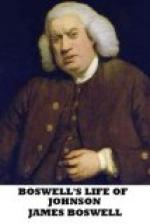Boswell’s devotion to his work appears in even more extraordinary ways. Throughout he repeatedly offers himself as a victim to illustrate his great friend’s wit, ill-humor, wisdom, affection, or goodness. He never spares himself, except now and then to assume a somewhat diaphanous anonymity. Without regard for his own dignity, he exhibits himself as humiliated, or drunken, or hypochondriac, or inquisitive, or resorting to petty subterfuge—anything for the accomplishment of his one main purpose. ‘Nay, Sir,’ said Johnson, ’it was not the wine that made your head ache, but the sense that I put into it.’ ‘What, Sir,’ asks the hapless Boswell, ‘will sense make the head ache?’ ’Yes, Sir, when it is not used to it.’
Boswell is also the artist in his regard for truth. In him it was a passion. Again and again he insists upon his authenticity. He developed an infallible gust and unerring relish of what was genuinely Johnsonian in speech, writing, or action; and his own account leads to the inference that he discarded, as worthless, masses of diverting material which would have tempted a less scrupulous writer beyond resistance. ’I observed to him,’ said Boswell, ’that there were very few of his friends so accurate as that I could venture to put down in writing what they told me as his sayings.’ The faithfulness of his portrait, even to the minutest details, is his unremitting care, and he subjects all contributed material to the sternest criticism.
Industry and love of truth alone will not make the artist. With only these Boswell might have been merely a tireless transcriber. But he had besides a keen sense of artistic values. This appears partly in the unity of his vast work. Though it was years in the making, though the details that demanded his attention were countless, yet they all centre consistently in one figure, and are so focused upon it, that one can hardly open the book at random to a line which has not its direct bearing upon the one subject of the work. Nor is the unity of the book that of an undeviating narrative in chronological order of one man’s life; it grows rather out of a single dominating personality exhibited in all the vicissitudes of a manifold career. Boswell often speaks of his work as a painting, a portrait, and of single incidents as pictures or scenes in a drama. His eye is keen for contrasts, for picturesque moments, for dramatic action. While it is always the same Johnson whom he makes the central figure, he studies to shift the background, the interlocutors, the light and shade, in search of new revelations and effects. He presents a succession of many scenes, exquisitely wrought, of Johnson amid widely various settings of Eighteenth-Century England. And subject and setting are so closely allied that each borrows charm and emphasis from the other. Let the devoted reader of Boswell ask himself what glamor would fade from the church of St. Clement Danes, from the Mitre, from Fleet Street, the Oxford coach, and Lichfield, if the burly figure were withdrawn from them; or what charm and illumination, of the man himself would have been lost apart from these settings. It is the unseen hand of the artist Boswell that has wrought them inseparably into this reciprocal effect.




